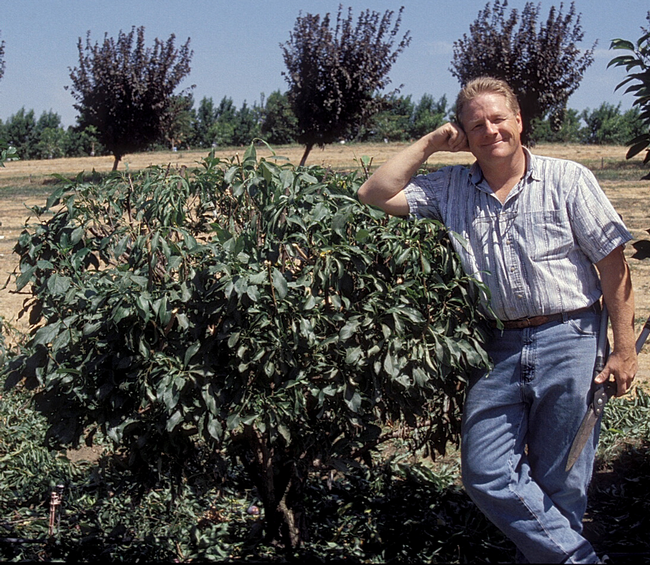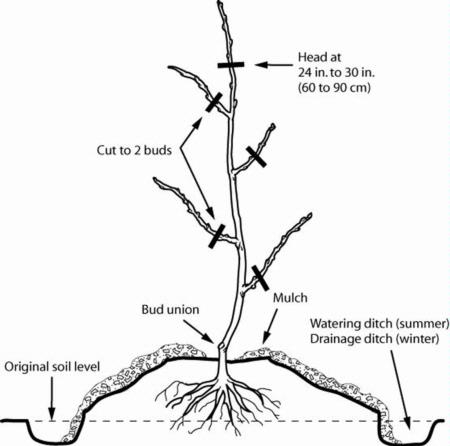
Did you know? Fruit trees can be kept under 6' tall so you can easily access the fruit. Surprisingly, although the trees are small, you will still get plenty of fruit!
UCCE Stanislaus County Master Gardeners hope to see you at a local Stanislaus County library branch to learn more.
- Tuesday, December 6, 2022 at 6:00 p.m. – Salida Library
- Monday, December 12, 2022 at 6:00 p.m. - Ceres Library
- Wednesday, December 14, 2022 at 2:30 p.m. - Patterson Library
- Wednesday, December 28, 2022 at 6:00 p.m. - Turlock Library
Backyard Orchard:Growing deciduous fruit trees is not for the faint-hearted. Trees such as apples, apricots, plums, pears, peaches, cherries, are not all pruned or managed the same way. Winter is the best time to plant a fruit tree, as you can purchase them as “bare root” fruit trees at a lower cost. You will learn how to correctly plant a bare root fruit tree, and how to prune it in the future to keep it small. This class does not include citrus, a separate class taught next spring.
Due to holidays conflicting with class dates, this class won't be offered at Riverbank, Oakdale, and Modesto Library locations.
Contact your local library branch to find out more. Missed a class you wanted to take? Watch it on our YouTube Channel! http://ucanr.edu/youtube/ucmgstanislaus
*Unfortunately, deciduous fruit trees that lose their leaves like apple, plum, pear, apricot, and cherry, have root systems that grow too large for containers. Luckily, you can plant many citrus tree varieties in containers.
- Author: Ed Perry
For gardeners the coming of winter means, among many other things, the beginning of the bare root planting season. Local nurseries will soon receive good supplies of bare root fruit and ornamental trees, roses, grapes, berries, and vegetables such as asparagus and rhubarb. Unlike container plants, bare root plants are dug from the field when dormant and separated from the soil. This allows the nursery grower to ship plants at a lower cost and means a good saving for the buyer.
Since all the soil has been removed from the roots, take care to prevent them from drying out while you transport the tree or dig the planting hole. Never allow the plant roots to be exposed to sun and wind for more than just a few minutes. You can protect the roots for a few hours by placing them in a moist plastic bag or by covering them with wet newspaper or cloth. It's best to plant and water your bare root trees right away. If you need to delay planting for a day or more, you should “heel in” the plants. “Heeling in” is a method of protecting plant roots by placing the plants into a hole or shallow trench and covering the roots with moist soil, sand or sawdust.

You should consider trees, shrubs and other perennial plants to be long term investments. It's therefore worth the effort to pick the proper place for the plant. Fruit trees especially need full sun to produce properly, as well as room to grow. Most standard fruit trees can be planted 10 to 15 feet apart, or much closer if you are willing to spend time doing heavy pruning and careful training each year. Semi-dwarf fruit trees are good choices for a garden with limited space. It is not a good idea to plant a fruit tree in a lawn area, as the lawn's water requirements are not compatible with those of the tree. Fruit trees growing in lawns often grow poorly or are killed by shallow, frequent lawn irrigation.
Fruit trees prefer well drained soils at least 3 or 4 feet deep but will grow in shallower soils if you water carefully. Plant your tree when the soil is moist enough to dig easily. Do not plant in wet, sticky soil. The planting hole should be 2 to 3 times wider than the root spread, but only deep enough to plant the tree at the same level as it grew in the nursery. A tree planted in a deep hole will settle too much after watering. When this happens the tree is often attacked by a soil borne fungus disease where the soil contacts the trunk.
Before you plant the tree, carefully cut off broken or badly damaged roots with sharp pruning shears. Do not prune the roots to fit the hole. If necessary, put soil in the bottom of the hole so that the tree is slightly higher than the soil line. This will allow the tree to settle slightly without becoming buried. Using the same soil that came out of the hole, carefully cover the roots completely, then water thoroughly to settle the soil around the roots. You may want to complete the planting job by placing a mulch on the ground around the tree to help control weeds and conserve moisture.
For more information on care of your newly planted bare root fruit trees, berries, grapes, and roses, visit The California Backyard Orchard.
Winter is the time of year when many people prune their deciduous fruit trees. However, did you know that now is not the right time to prune apricot and cherry trees?
In the past, home gardeners were advised to prune stone fruit trees (cherries, apricots, plums, peaches, and nectarines) after trees lose their leaves and go dormant. However, cherry and apricot trees are more likely to be attacked by certain diseases that can be spread by rain.
Gardeners who prune cherry and apricot trees during winter create wounds that may be invaded by fungal and bacterial canker diseases. Symptoms show up in spring and summer, when infected tree limbs wilt and suddenly die with their leaves still attached, or when bark becomes discolored and limbs produce an amber-colored ooze.
This year, wait to prune apricot and cherry trees until late spring or early summer. For more information about fruit trees, visit The California Backyard Orchard.

![Oozing from fungal infection in cherry that was pruned during the cool season. [Credit: Chuck Ingels, UCCE Sacramento] Oozing from fungal infection in cherry that was pruned during the cool season. [Credit: Chuck Ingels, UCCE Sacramento]](http://ucanr.edu/blogs/StanislausSprout/blogfiles/57473.jpg)
